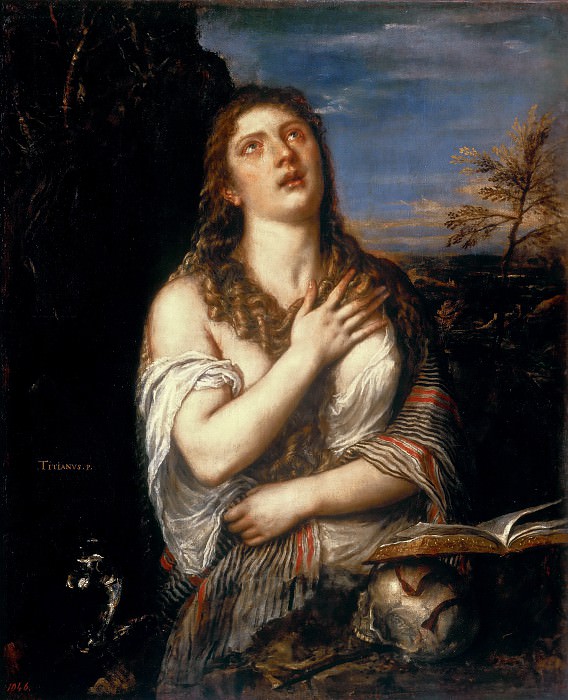Repentant Mary Magdalene Titian (Tiziano Vecellio) (1488/90-1576)
Titian – Repentant Mary Magdalene
Edit attribution
Download full size: 2771×3418 px (2,3 Mb)
Painter: Titian (Tiziano Vecellio)
Location: Hermitage, St. Petersburg (Эрмитаж).
Titiano Vecellio painted his commissioned work The Penitent Mary Magdalene in the 1960s of the 15th century. The model was Giulia Festina, who delighted the artist with her voluminous mop of gold hair. The Duke of Gonzaga was very impressed with the finished work, and he decided to commission a copy. Titian later painted a couple more similar works, varying the background and the woman’s pose. An old legend has it that, dying, Titian picked up this very canvas.
Description of Titian Vechellio’s painting of Mary Magdalene in Repentance
Titiano Vecellio painted his commissioned work The Penitent Mary Magdalene in the 1960s of the 15th century. The model was Giulia Festina, who delighted the artist with her voluminous mop of gold hair. The Duke of Gonzaga was very impressed with the finished work, and he decided to commission a copy. Titian later painted a couple more similar works, varying the background and the woman’s pose.
An old legend has it that, dying, Titian picked up this very canvas. After the artist’s departure (1576), the painting went to his heir, Pomponio Vechellio, who in turn sold it, along with other works at the sale of the house of Cristoforo Barbarigo in 1581.
The famous painter Titian was a unique personality. He masterfully transformed the repentant harlot who followed Jesus Christ across the wilderness in order to humble her own flesh and wash away the stigma of shame, into a wonderful sense of grace and love. From the canvas a woman looks out at us, her figure slightly covered by an airy cloth. Her gold-colored hair is scattered across her chest in thick curls. The gaze of this genius of pure beauty is directed to the sky. The woman with her head thrown back in front of her eyes is pleading, tearfully asking for forgiveness.
Despite the title ("Penitent Mary Magdalene"), the canvas clearly shows that the woman is not repenting, it emanates a gracious feeling of love. Titian has an allegorical connotation: the book unfolded in front of the repentant woman lies on a skull, and this is not a good sign.
From a slightly different perspective, the painter saw the meaning of the painting - he portrayed both a beautiful young woman and deep sorrow, as well as faithful love, in the image of Mary. The silhouette on the canvas is set against a sad background: you can see a gloomy cliff, a blue-gray sky, and emaciated trees. And amidst this gloom she is Mary Magdalene, the embodiment of womanhood.
Кому понравилось
Пожалуйста, подождите
На эту операцию может потребоваться несколько секунд.
Информация появится в новом окне,
если открытие новых окон не запрещено в настройках вашего браузера.
You need to login
Для работы с коллекциями – пожалуйста, войдите в аккаунт (open in new window).




















COMMENTS: 1 Ответы
МАГДАЛИНА
Слёзы притупляют зренье,
Внутреннее зренье отворив.
И для Магдалины вне сомненья
Вся реальность в настоящем – миф.
Обмывает ноги без сандалий.
Что же видит? Всадников разъезд,
Видит чётко завтрашние дали,
Рвущийся – и к центру мира – крест.
Сердце – средоточье тела. Слово
Средоточье жизни. Слово-плоть.
Обмывает ноги…Но сурово
Будущее – вовсе не Господь.
Александр Балтин. МАГДАЛИНА
Широко Господь раскинет руки,
Чтоб любовью старый мир омыть.
Чтобы, испытав святые муки,
Грех избыть, погибель отменить.
Ибо за распятьем – воскресенье,
Ибо Магдалина дорастёт
Сердцем и душой до постиженья
Нами не постигнутых высот.
You cannot comment Why?
The painting is rich in symbolism. At her side rests a skull, a memento mori, a stark reminder of mortality and the transient nature of earthly life. Beside the skull lies an open book, likely a Bible or prayer book, signifying her devotion and turn towards religious solace. The background is divided, with a dark, barren landscape on the left, possibly representing her past sins or a desolate spiritual state, contrasted with a more open, albeit somewhat bleak, sky and a solitary tree on the right, hinting at a path towards redemption and spiritual renewal.
The subtext of the painting revolves around themes of sin, repentance, and salvation. Mary Magdalene, traditionally understood as a repentant sinner who found forgiveness through Christ, is presented here as an archetype of human fallibility and the possibility of redemption. Her emotional intensity and the symbolic elements convey a powerful message about the struggle for spiritual purity and the solace that faith can offer in the face of worldly temptations and the inevitability of death. The painting invites the viewer to reflect on their own mortality, the nature of sin, and the transformative power of repentance and divine grace.